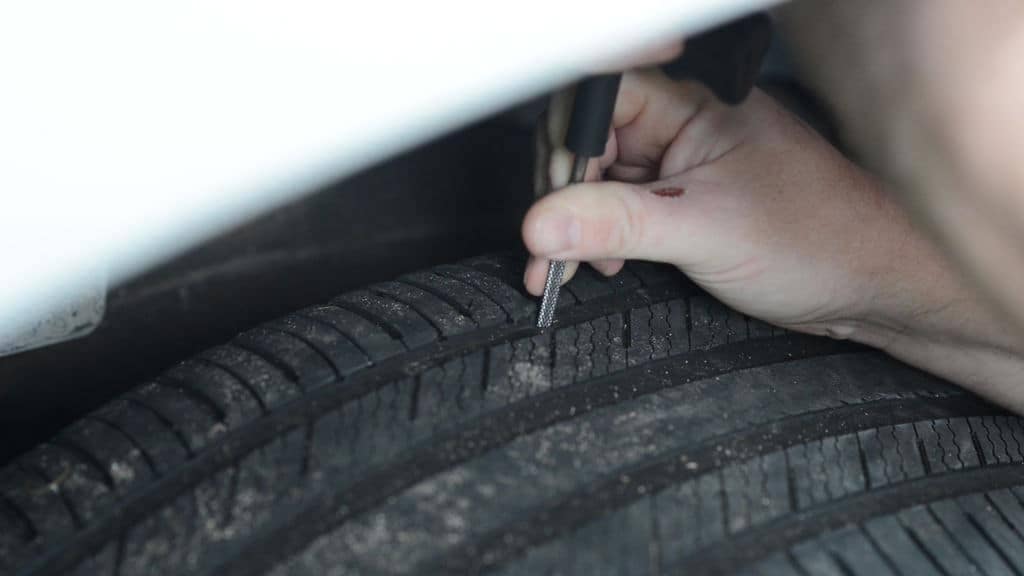Run-flat tire repair procedures recommended by the U.S. Tire Manufacturers Association (USTMA) are the same for both run-flat and non-run-flat tires.
Photo courtesy of Goodyear Tire and Rubber Co.
What should a fleet professional know when utilizing assets with run-flat tire versus a non-run-flat tire? According to mounting and balancing equipment manufacturers and tire manufacturers the consensus is a run-flat’s unique construction makes them more difficult to mount and demount.
However, there is no consensus on whether or not run-flat tires can be repaired. Tire manufacturers often defer to the vehicle manufacturer’s replacement tire restrictions and recommendations.
Michelin North America Inc., for example, allows its run-flat tires (Zero Pressure) to be repaired under certain guidelines. However, repairing the original equipment run-flat tires on a BMW isn’t an option, per its owner’s manual.
Run-flat tire repair procedures recommended by the U.S. Tire Manufacturers Association (USTMA) are the same for both run-flat and non-run-flat tires. USTMA does preface that by advising vehicle owners to consult the tire manufacturer for its repair policy and, if applicable, recommended repair procedures.
When asked if there are any instances where a run-flat tire can be repaired, a Pirelli Tire LLC spokesperson said no, a run-flat should never be repaired.
According to Pirelli’s Run-Flat Hazzard Policy, “damaged run-flat tires or run-flat tires that have experienced a loss of pressure should immediately be replaced with another run flat tire of identical size and service description (load index and speed symbol).”
A technical services bulletin from Yokohama Tire Corp. makes it clear Yokohama ZPS run-flat tires are not to be repaired following a puncture “or other tire disablement.”
“ZPS run-flat tires are covered by the Yokohama standard limited warranty that provides for tire replacement under specified conditions,” the bulletin reads. “Your ZPS tire will be replaced on a prorated basis based on remaining tread depth when the tire has been damaged due to a tread area puncture within the repairable area and limits defined by (USTMA).”
“Your ZPS tire will be replaced on a prorated basis based on remaining tread depth when the tire has been damaged due to a tread area puncture within the repairable area and limits defined by (USTMA).”
Continental Tire the Americas LLC does not recommend any repair to Continental SSR (Self Supporting Runflat) tires. The company’s explanation is as follows: “Even a trained tire specialist may be unable to recognize internal structural damage to a Self Supporting Runflat (SSR) tire resulting from having been driven in an under inflated or zero pressure condition. Such damage may not be visible on the surface of the inner liner or sidewall, making it impossible to determine the tire suitability for repair. Continental does not recommend any repair to Continental SSR tires. Note: Continental advises if a tire is returned under complaint and reason for the product’s disablement is in any way associated with a repair or the reason for repair, the manufacturer’s warranty is invalidated. ”
”
“Repairs of run-flats are a major concern,” says Chris Davis, Continental’s technical product service manager. “Always refer to the tire manufacturer’s recommendations on repairs as it can vary by manufacturer. Some allow a repair, some don’t and some allow multiple repairs, noting that each repair lowers the speed rating of the tire. Consider your dealership’s liability as the ‘tire expert’ agreeing the tire is not damaged, should you repair the tire without knowing damage between the layers.
“Run-flat tires, by design, have a very thick, stiff compound in the sidewall,” he said. It is typically not the same material that you can visualize on the inside or outside of the tire. If there is a separation between those layers, the dealer and the customer may not know about the condition until the tire has a second incident of low pressure causing the run flat tire not to work as designed, leaving the customer stranded on the highway or worse, having a rapid air loss and instability of control.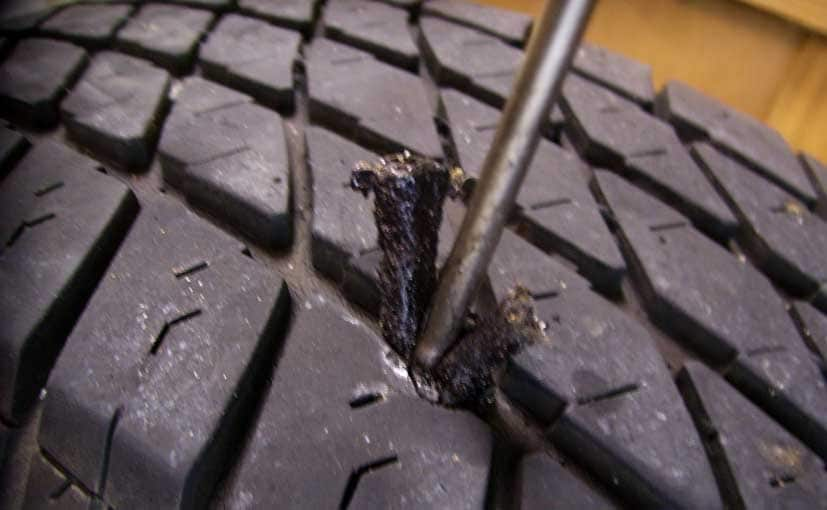
“Use your best judgment based on the tire manufacturer’s suggestions (and) customer safety, and if in doubt, contact the tire manufacturer’s customer service for recommendations,” he added.
Bridgestone Americas Inc. has a different view.
“Under certain circumstances, run-flat tires can be repairable,” said Robert Saul, director of consumer product strategy for Bridgestone Americas Tire Operations LLC.
There is no consensus whether run-flat tires can be repaired. Tire manufacturers often defer to the OEM's replacement tire recommendations.
“Guidelines vary by vehicle manufacturer, so it’s important for dealers to always abide by the vehicle manufacturer’s recommendations. Many tire manufacturers also will publish their repair and service guidelines in the form of technical bulletins, so dealers can check to see if the manufacturer of the tire they are servicing has a technical bulletin that they can refer to as well.
“In certain instances, a run-flat tire can be repaired, provided it meets specific guidelines,” said Saul. “These guidelines are contingent upon how far the run-flat tire was driven at low inflation conditions, the amount of air loss experienced and the overall condition of the tire. A run-flat tire that has experienced a puncture or loss of pressure must be thoroughly inspected for any resulting damage to determine if it can be put back in service.”
“These guidelines are contingent upon how far the run-flat tire was driven at low inflation conditions, the amount of air loss experienced and the overall condition of the tire. A run-flat tire that has experienced a puncture or loss of pressure must be thoroughly inspected for any resulting damage to determine if it can be put back in service.”
Juan Britos, senior technical services specialist for Hankook Tire America Corp., says Hankook’s run-flat models “can be repaired in the same manner as our standard versions. We design our tires to be repaired as simply as possible."
Pete Liebetreu, vice president of marketing for Hunter Engineering Co., said run-flat tires from European and Asian OEM manufacturers are very often mounted to a special wheel with an Eh3 (for “extended hump”) bead seat. Nokian “Flat Run” tires are one of many examples.
“We see these wheels every day in the U.S. on BMW, Lexus, Mercedes, Infinity, Toyota, Audi and other vehicles,” he said.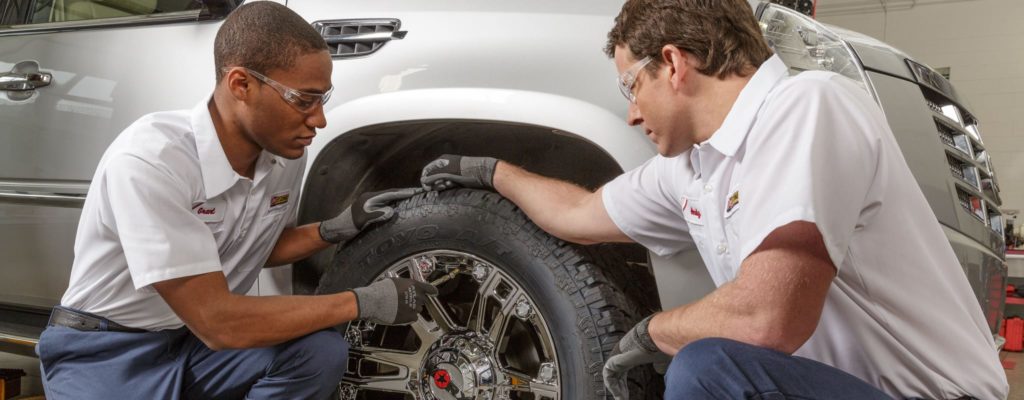
“The Eh3 wheel actually creates much of the difficulty in servicing these wheels, more than tire stiffness does. Eh3 means the wheel has an extended safety hump, which helps the deflated run-flat stay on the wheel properly in the event of a puncture,” he added.
“For the tire changer though, that extended hump makes it even harder to service. That’s because the already stiff tire needs to be pushed even further down to be in the drop center for demounting or mounting. Many technicians miss this and end up struggling with the tire that they could easily service if they pressed a little more on the key points with one of the press arms I mentioned earlier.”
A spokesperson from Bridgestone Americas Inc. said Eh3 (and Eh3+) wheels provide bead retention characteristics desired by car companies; in many cases they help extend run-flat operating distances, particularly at reduced loads.
“While Eh3/Eh3+ wheels are considered components of an extended mobility system, they are not explicitly restricted from use without other system components. In other words, Eh3/Eh3+ wheels may be able to be used with conventional tires or with conventional valves (without TPMS sensors).”
In other words, Eh3/Eh3+ wheels may be able to be used with conventional tires or with conventional valves (without TPMS sensors).”
According to Bridgestone’s warranty manual, Bridgestone and Firestone RFT tires should never be replaced or mixed with conventional tires unless on an emergency or temporary basis.
This feature orginially appeared in Modern Tire Dealer, a Bobit publication.
Run flat tires: Does this tire look flat to you? I couldn’t tell either, even when it was.
A really great thing happened to me recently: I had a flat tire.
Or rather, I didn’t have a flat tire, I had a damaged run flat tire. Because I have run flat tires on my car, it’s impossible to have a truly flat tire.
A Girls Guide to Cars may earn a commission from links contained on this page, but don’t worry, we only recommend products we love? And, there is no additional cost to the buyer when a purchase is made by clicking these links.
I first heard about run flats when I was thinking of buying my car, and this was a major selling point. Run flat tires don’t ever actually go flat. They are made of very stiff rubber and a very thin inner tube that when fully deflated, still can support the weight of the car. You can drive 100 miles or so on a flat tire, which means you never need to change a tire on the side of the road, you don’t have to call for roadside assistance and you don’t have to stop what you’re doing get the tire changed. You just drive your car to the tire dealer and have it taken care of.
I discovered I had a flat tire when the tire pressure monitor sensor went off. I reset it, according to the manufacturer’s instructions and it quickly came back on again.
A few days later, when I had time, I took the car to the car dealer. The tire was flat, I was told, and it would have to be replaced. So they replaced it. An hour, a cup of coffee and $250 later, I was on my way. While the tire was expensive and I could have gotten it cheaper if I’d gone to a tire store rather than the dealer, I was happy that I could have the tire changed at my convenience, I didn’t have to wait for a tow truck or roadside assistance, and I wasn’t left stranded by the experience.
While the tire was expensive and I could have gotten it cheaper if I’d gone to a tire store rather than the dealer, I was happy that I could have the tire changed at my convenience, I didn’t have to wait for a tow truck or roadside assistance, and I wasn’t left stranded by the experience.
Further reading: Our Continental run flat tire review
Make sure your tires are in good condition. Photo: Scotty Reiss
Run flats are more expensive than regular tires.
Partially because they are ‘performance’ tires designed for high end or performance cars, and partially because they are a smaller part of the market, they tend to be more expensive. Also, when you have a damaged run flat tire, you most likely will have to replace it; they can’t be patched or reused. However, I’ve never had a flat that I didn’t have to replace (isn’t that an urban myth?).
Run flat tires are also a rougher, louder ride. Every time you hit a pothole it feels as if you’ve hit a deer—it can be jarring and you’re sure you’ve done damage to your car (even though you most likely haven’t).
Every time you hit a pothole it feels as if you’ve hit a deer—it can be jarring and you’re sure you’ve done damage to your car (even though you most likely haven’t).
Further reading: Michelin is helping teens to learn about tire safety
Run flat tires are about to become more common. Tire companies, realizing that consumers like the idea of never having a flat tire, that most new cars are built with TPMS, or tire pressure monitoring sensors—necessary because you can’t tell that a run flat tire is flat by looking at it—and that shedding the cost and weight of a spare tire ($200 and 70 lbs!) saves money and fuel, they’ve stepped up product development.
Soon expect to hear about new run flats that are more comfortable to drive and less expensive. And, if you have an older car without a TPMS, you can still switch to run flats: A TPMS system can be purchased at an auto parts store for under $200.
Journalist, entrepreneur and mom, Scotty likes to say the automotive business found her, she didn't pursue it. But recognizing the opportunity to give voice to powerful female consumers and create a voice to match their spending power, her mission became to empower women as car buyers and owners. A career-long journalist, she has written for the New York Times, Town & Country, Adweek and co-authored the book Stew Leonard, My Story, a biography of the founder of the iconic grocery company Stew Leonard’s. Her love of cars started when her father insisted she learn to change the oil in her MG Midget, but now it mostly plays out in the many road trips taken with her family.
But recognizing the opportunity to give voice to powerful female consumers and create a voice to match their spending power, her mission became to empower women as car buyers and owners. A career-long journalist, she has written for the New York Times, Town & Country, Adweek and co-authored the book Stew Leonard, My Story, a biography of the founder of the iconic grocery company Stew Leonard’s. Her love of cars started when her father insisted she learn to change the oil in her MG Midget, but now it mostly plays out in the many road trips taken with her family.
Author: Aleksey Kokorin
Experienced drivers are not surprised by such a trifle as a puncture, but for the first time beginners usually get confused in the sequence of actions, forget about important details and do not know what to do with a punctured wheel even in a tire shop - especially if they start offering choose from several options or intimidate with expensive repairs.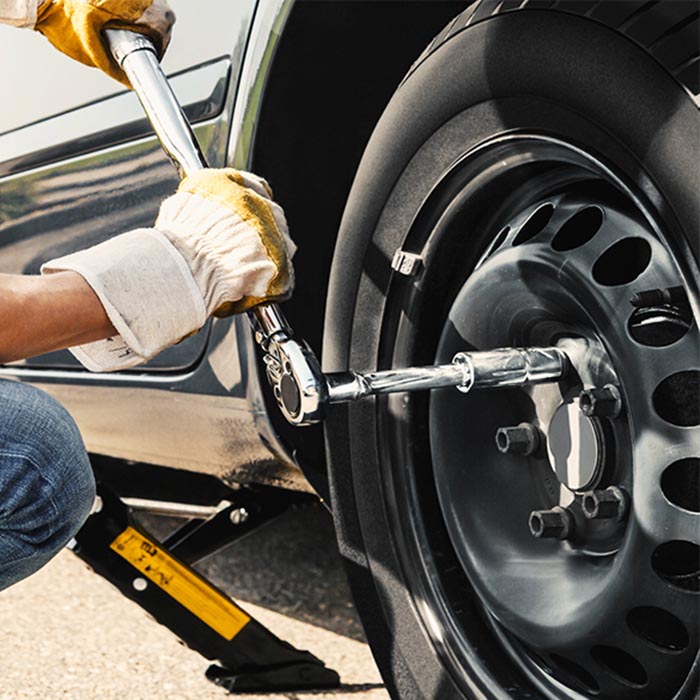 Let's set up an operation algorithm when a flat tire is detected and figure out what to do right away and what to choose later.
Let's set up an operation algorithm when a flat tire is detected and figure out what to do right away and what to choose later.
What to do when you find a puncture
Having found a flat tire, first of all you need to stop in a safe place, turn on the emergency alarm, assess visibility and, if necessary, set an emergency stop sign: according to traffic rules, it is installed at least 15 meters from the car in built-up area and at least 30 meters outside the built-up area. When choosing where to stop, consider the space to the side of the vehicle to handle a flat tire. You should not stop right on the road and in places where stopping and parking are prohibited: even if a punctured wheel belongs to the conditions of a forced stop, it is quite possible to drive several tens of meters on it to choose a safe and convenient parking place. At night or in conditions of limited visibility (for example, in fog or rain), it is imperative to wear a vest with retroreflective elements - this is required by clause 2. 3.4 of the SDA and common sense.
3.4 of the SDA and common sense.
Now you can start working on the wheel. We will sequentially consider several options for action, and then move on to ways to repair a damaged tire.
The most obvious solution to a flat tire is to replace it. If you have a spare tire that you are sure is in good condition, the best option is to install it and visit a tire shop to repair a punctured tire - such repairs will be more reliable and of high quality than doing it yourself.
If you don't have a suitable spare tire, but you do have a pump or compressor, you can assess the damage to the tire and try to pump it up again to get to the tire shop. It is better to start searching for an air leak with a valve (aka “nipple” or “nipple”): often a faulty spool becomes the cause of a flat tire. It is easy to check it: unscrew the protective cap (if there is one), pour water on it (or slobber it, as in childhood): air bubbles will leak. In this case, you can try to replace the spool valve by unscrewing it and screwing in a new one, but if there is no new valve, as well as a store nearby, you can try just unscrewing and screwing it back in. Regardless of whether it helped or not, you need to visit a tire shop to replace the entire spool or valve.
Regardless of whether it helped or not, you need to visit a tire shop to replace the entire spool or valve.
If the valve is tight and the tire is flat, it is most likely a puncture. The easiest way to find a puncture that is free of foreign objects is to pour water on the tire while looking at the surface: the damage will reveal itself as air bubbles. However, often the cause of the puncture can be found along with it: a self-tapping screw, nail or other arbitrary object sticking out of the wheel will clearly indicate the place of depressurization. In this case, you do not need to immediately remove the foreign object from the tire: it partially seals the hole, and if the pressure loss is slow, you can try to pump up the wheel and drive to the tire shop.
The same goes for wheels that are leaking from the rim or from a faulty valve. Usually, in this case, the air is bled slowly, and you can pump up the wheel and have time to get to the place of repair. By the way, rim leakage can occur due to disk deformation upon impact - for example, when hitting a pit with sharp edges. Such situations are fraught with damage to both the disk and the sidewall of the tire, in which case the disk will need to be corrected, and the tire repaired or even replaced. To avoid rim leaks, you need to inspect the rims every time you change tires. The loss of tightness occurs either due to corrosion or due to disc deformation, and not only steel, but also light alloy wheels can corrode. So if you see paint blistering or rust on the rim, the tires need to be put on rim sealant: when changing tires, this will be cheaper than the subsequent removal and re-tire to fix a leak on the rim.
Such situations are fraught with damage to both the disk and the sidewall of the tire, in which case the disk will need to be corrected, and the tire repaired or even replaced. To avoid rim leaks, you need to inspect the rims every time you change tires. The loss of tightness occurs either due to corrosion or due to disc deformation, and not only steel, but also light alloy wheels can corrode. So if you see paint blistering or rust on the rim, the tires need to be put on rim sealant: when changing tires, this will be cheaper than the subsequent removal and re-tire to fix a leak on the rim.
If you find a puncture, but there are no foreign objects in it, and you do not have a spare wheel and tire repair kits, there is another popular method of temporary "repair". You can screw a self-tapping screw into the found hole - if, of course, you have one. In extreme cases, you can look for a self-tapping screw in the cabin by unscrewing it from some interior detail. This method cannot be called reliable: it is unlikely to ensure complete tightness of the wheel, but at least it can help you get to the nearest tire shop.
And a couple more useful remarks. If the wheel is completely flat, then it is easier to inflate it without a spool: the latter must be unscrewed, then the tire must be inflated and quickly screwed back in. The fact is that the spool itself, when inflated, resists the compressor, and in the event of a loose fit of a flat tire to the disk, the power of a simple magazine compressor may not be enough, and the absence of a spool helps to increase air flow and facilitate the operation of the compressor. If this does not help, you can jack up the car by hanging a flat tire: this will improve the fit of the tire to the disk, and the chances of inflating the tire will increase.
On-Site Repair Methods
Now let's look at options for repairing a tire yourself using special materials that you should carry with you or, if a puncture caught you in the city, buy it at the nearest auto shop.
1. The most common, cheapest and easiest way to do it yourself is to install a raw rubber band. The harnesses are sold complete with an abrasive awl to expand the hole in the tire and improve the contact of the repair harness with its edges, as well as a needle for installing the harness and an adhesive to fix it and at the same time seal the puncture. When choosing a repair kit in a store, you should pay attention to the following nuances:
The harnesses are sold complete with an abrasive awl to expand the hole in the tire and improve the contact of the repair harness with its edges, as well as a needle for installing the harness and an adhesive to fix it and at the same time seal the puncture. When choosing a repair kit in a store, you should pay attention to the following nuances:
Install the harness in the following order. First, the found hole is expanded with an abrasive awl - you need to insert and remove it several times into the puncture site. Then the tourniquet is inserted into the eye of the needle, and glue is applied to it. After that, the needle with the tourniquet must be inserted into the hole in the tire and pulled out sharply - so that the tourniquet remains in the hole, and the needle comes out without it. If everything worked out, it remains only to cut the end of the harness flush with the surface of the tire and pump up the wheel.
If everything worked out, it remains only to cut the end of the harness flush with the surface of the tire and pump up the wheel.
The advantages of repairing with a harness are quite decent reliability, simplicity and low cost. On a well-repaired tire, you can drive for a long time, and if the repair site starts to poison, you can either replace the harness or have the tire repaired in a quality service. Among the minuses is the possibility of damaging the cord during installation, as well as lower reliability compared to “full-fledged” repair methods in a tire shop. Strictly speaking, a tourniquet is still a temporary repair, so if it is possible to pump up a wheel and get to a tire fitting, then it is better not to enlarge the hole in the tire and get to the experts.
2. The second repair option is aerosol liquid sealants sold in cans. To repair a punctured tire with sealant, you need to remove the foreign object from the puncture site, then pour the sealant into the wheel through the valve, twist it to distribute the composition inside the tire, pump up the wheel and drive several kilometers at low speed for the final uniform distribution of the sealant.
Among the advantages of this repair is the simplicity and less labor intensity compared to installing a harness. However, there are also disadvantages: the larger the hole, the higher the chance that the sealant will not be able to eliminate it, and such a repair can affect the wheel balance. Compared to a tourniquet, it can be considered even less reliable and preferable, but simpler.
Repair options at a tire shop
If you put on a spare tire and brought the wheel to a tire shop, you may also be offered several repair options. Consider the most popular with an indication of the advantages and disadvantages.
1. The first repair method is the same harness installation as described above. As we remember, the tourniquet refers to a temporary repair, so among tire specialists this method is considered bad form, but many workshops do not exclude it from the list of services. All the advantages and disadvantages are the same here: such a repair will be the fastest, simplest and cheapest, but less reliable than other methods. It is worth choosing it in cases where the price and / or speed of the procedure is more important to you than anything else. If quality is a priority, then it is better to fork out for the options listed below.
It is worth choosing it in cases where the price and / or speed of the procedure is more important to you than anything else. If quality is a priority, then it is better to fork out for the options listed below.
2. The second option for repairing a puncture is to install a patch on the inside of the tire, the so-called cold vulcanization. In this case, the tire is removed from the disk, the surface around the puncture is treated with an abrasive, and the damage is sealed with a special patch. This is a more preferred repair method than a tourniquet: it is more reliable and durable, especially in the case of side punctures, when not the thick tread part of the tire is damaged, but the thinner sidewall. Among the minuses, only a higher cost can be noted: in addition to the actual tire repair, you will have to pay for the removal and installation of the wheel (or do it yourself), tire fitting and balancing.
3. The third option is a "complex" of the first and second: installation of the so-called repair "fungus".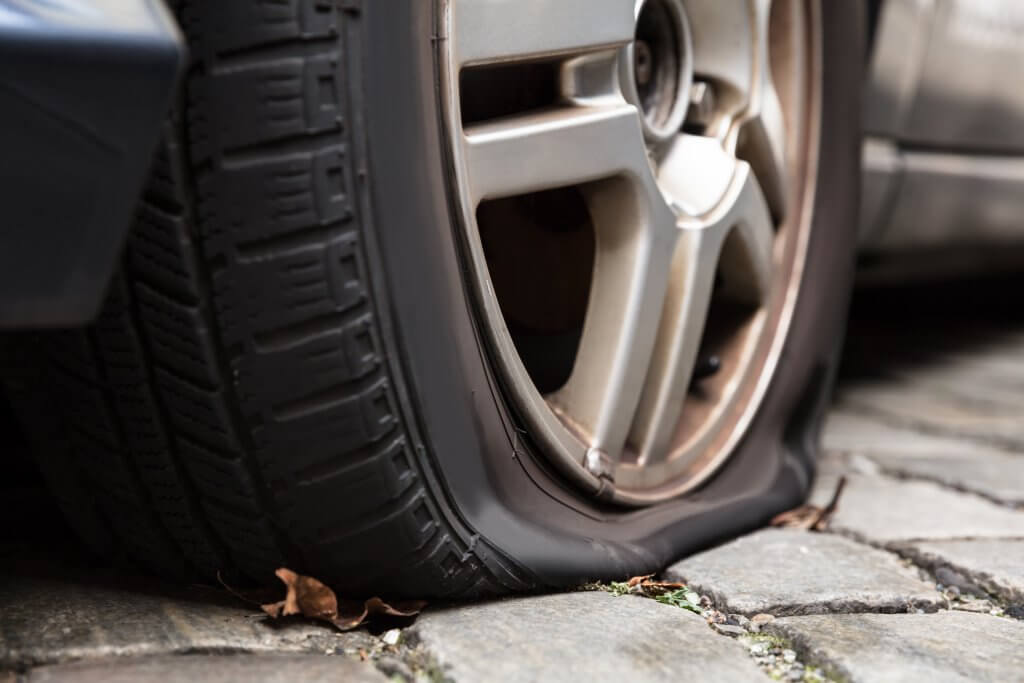 The “hat” of the fungus is a patch, and the “leg” is threaded from the inside of the tire to the outside. After gluing the patch, the excess part of the leg is cut off, as in the case of the tourniquet. Thus, not only the inner surface of the tire is closed, but also the hole itself. The advantages and disadvantages of this repair method are generally the same as those of a patch.
The “hat” of the fungus is a patch, and the “leg” is threaded from the inside of the tire to the outside. After gluing the patch, the excess part of the leg is cut off, as in the case of the tourniquet. Thus, not only the inner surface of the tire is closed, but also the hole itself. The advantages and disadvantages of this repair method are generally the same as those of a patch.
4. An extreme, “emergency” measure when repairing a punctured wheel is to install a camera in it. Typically, this method is used for tires that are no longer worth repairing, or “for reliability” after repairing a complex puncture. It should be understood that almost all modern tires are tubeless, that is, they are not designed to install a camera, so it’s not worth driving a wheel repaired in this way for a long time. Installing a tube is a temporary solution for riding until a new tire is purchased, and sometimes such wheels are left as spares. So this repair method can be kept in mind as a backup.
Finally
We have deliberately left out of this text such methods as combined repair of tires with a tourniquet and a patch and hot vulcanization. The first is used quite rarely and for specific damage, and it is enough just to know about its existence. Well, the second is used to repair serious side cuts, and it is not only rare, but also very expensive. The cut site in this case is prepared, filled with raw rubber and processed with a hot press for vulcanization. Equipment for this procedure is not available in every tire shop, and the cost of repair can be about half the cost of a new tire.
interesting popular questions
Articles / Practice Stop on demand: what breaks in the brake master cylinder Everyone used to know what a master brake cylinder (or just a GTZ) is. Now they remember him much less often: the GTZ has noticeably increased reliability, and on new machines it practically does not fail .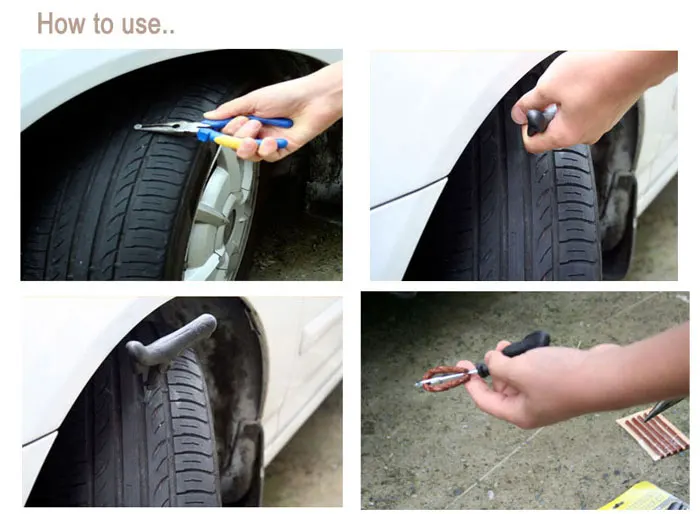 ... 120 0 one 10/14/2022
... 120 0 one 10/14/2022
Articles / Travel Air sellers: how cunning businessmen make money in lines at the borders The past two weeks have been marked by huge queues of cars at the borders of Russia and neighboring countries. And where there are queues, difficulties and excitement, there are always those who want to catch... 241 0 2 10/14/2022
Articles / Used cars Range Rover Evoque I with mileage: durable suspension, the right oil and no Ford engines We have already praised the Range Rover Evoque for its stainless body, scolded the unimportant multimedia and blamed the models for capricious electrics.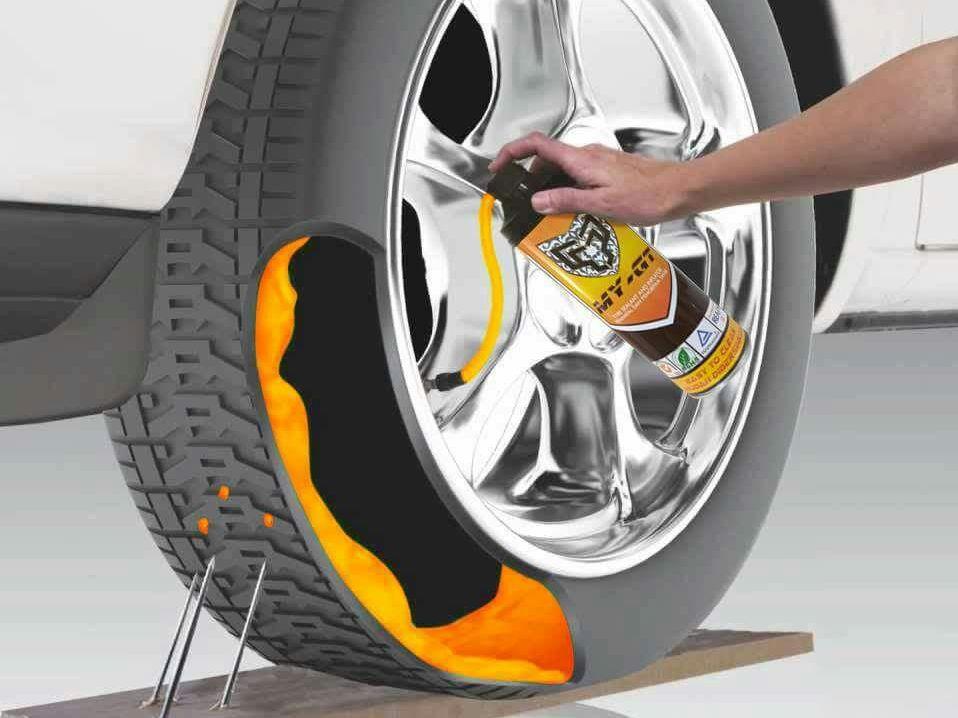 It's time to figure out which motors to avoid... 1178 0 one 10/13/2022
It's time to figure out which motors to avoid... 1178 0 one 10/13/2022
Test drives / Test drive Haval Dargo vs Mitsubishi Outlander: the dog is barking, the stranger is coming In the Haval dealership in the south of Moscow, life is in full swing: buyers look at cars, communicate with managers and sign some papers. While I was waiting for the test Dargo, the same cross... 13311 7 170 13.09.2022
Test drives / Test drive Motor from Mercedes, emblem from Renault, assembly from Dacia: test drive of the European Logan 1.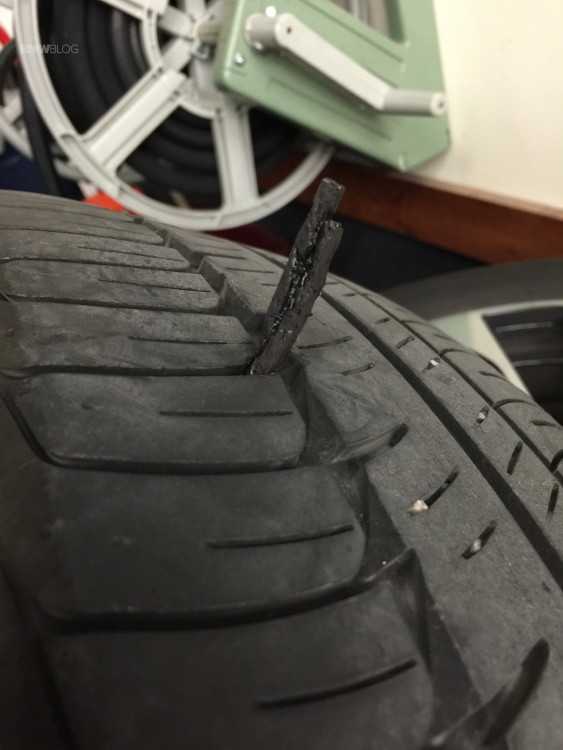 0 It would seem that what's new can be told about the second generation Renault Logan, known to every Russian taxi driver, as they say, up and down? However, this car has... 11566 ten 41 08/13/2022
0 It would seem that what's new can be told about the second generation Renault Logan, known to every Russian taxi driver, as they say, up and down? However, this car has... 11566 ten 41 08/13/2022
Test drives / Test drive Geely Coolray vs Haval Jolion: Free Cheese? If! Do you want to buy a car today with a full warranty, on credit at an adequate rate, without wild dealer markups? Now this is still a task, because a full-fledged chain of "representation - s... 8506 25 thirty 08/10/2022
Another season of changing shoes is approaching. And you may remember that on one of the tires after the last winter/summer there is a jamb - a small bump. I don’t want to run to the store for the sake of one new tire. We understand. Or maybe it looks even better if repaired?
And you may remember that on one of the tires after the last winter/summer there is a jamb - a small bump. I don’t want to run to the store for the sake of one new tire. We understand. Or maybe it looks even better if repaired?
Yes, not every wheel that meets with a nail, rebar sticking out of the ground or a sharp stone on the road is considered damaged. Everything, of course, depends on the scale of the damage and its location on the tire itself. Some are easily repaired, while others are simply impossible to do - the tire can only be sent to the trash.
A bulge on a wheel, referred to by drivers as a bump or bulge, is the most common tire sidewall defect. It appears due to a collision with an obstacle or after falling into a pit, more often at high speed. The threads of the sidewall carcass are easily damaged by impact, and the tire at this point can no longer hold the load and air pressure - swelling appears. A small bump sooner or later turns into a big one, and driving with such a defect is dangerous - the wheel can shoot at any moment. At high speed, this is fraught with loss of control, departure from the road and a rollover.
At high speed, this is fraught with loss of control, departure from the road and a rollover.
The quality of roads in Kazakhstan contributes to the appearance of bulges on tires
Some types of bulges are repairable, although this is a temporary measure. Not a single patch can restore the factory rigidity. Ideally, change the tire.
Special cord patches can extend the life of a tire with a herniation, even if the swelling has appeared on the tread. The sidewall is a different story. If the swelling appeared at a distance of more than 40 mm from the side, it can be repaired. If not, then the wheel needs to be replaced. Blisters on low profile tires are most often non-repairable.
For maximum safety when riding with a repaired bump, insert the tube. This is an inexpensive and reliable solution. On our market, you can find cameras made in China and Russia, the latter are slightly more expensive, but also of better quality.
The elimination of a side cut is a serious operation, therefore, as in the case of a bump, you will have to go to the professionals. We need cord patches, fortunately in our time they are of different sizes and with a different number of layers. And if you do it wisely, then you can't do without special tools and vulcanization.
We need cord patches, fortunately in our time they are of different sizes and with a different number of layers. And if you do it wisely, then you can't do without special tools and vulcanization.
A cut, by the way, can not be healed in all cases. If the gap is in the shoulder area of the tire, it is unlikely that anyone will undertake to repair it, since no guarantees can be given here. However, our Kulibins take on even the most difficult cases, cutting out parts of the sidewalls from the tires and even weaving the cord on their own.
Tire overhaul. We wouldn't put such a wheel on ourselves
Low-profile tires can be repaired, but more difficult. A tear in the sidewall is easier to seal on tires with a medium or high profile.
Sometimes a cut is confused with a pluck. This is when the outer layer of the sidewall caught on something sharp, a tear formed, but the frame itself remained intact. There is nothing wrong with that, although the drivers at the tire fitting company successfully repair the cut, for which they take it accordingly.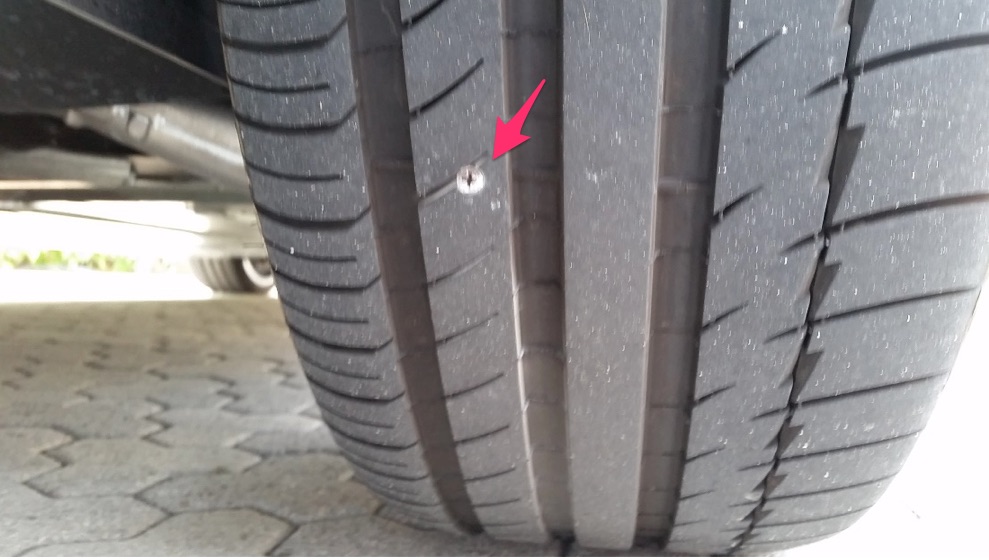
If a piece of rubber remains on the sidewall, then glue it with ordinary superglue (101st). If it came off, then it is better to cover it with raw rubber and vulcanize. Leaving the pluck bare is not recommended, because the tire carcass, often consisting of a metal cord, will quickly corrode.
In Europe, defective or used tires are perforated before being sent for scrap to prevent their resale and possible operation. But they don’t know that we have such holes on the sidewall patched once or twice
Cuts and hernias are not the only possible damage to the side of the tire. You can also spoil the side ring, in the process of changing shoes, for example. If it’s for garlic, then such a tire is already dangerous. Sooner or later, the tire pressure and the load in motion will start to squeeze the rubber off the rim - a wheel explosion can occur.
Repair of this ailment is taken if the wire ring - the base - is intact.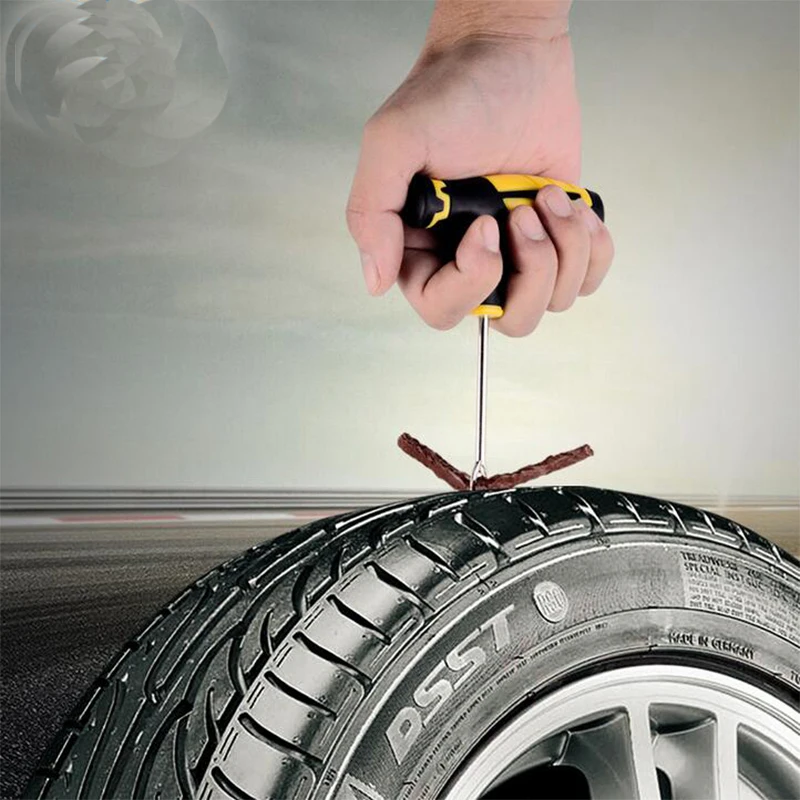 There are no special technologies and materials to correct this particular problem, but most often craftsmen use a two-component composition for chemical (also called cold) vulcanization. After mixing, the mass is pressed into a fat-free damage. Compound manufacturers recommend waiting 72 hours before mounting a tire. Of course, our masters do not pay attention to this condition - they put the tire right away. And it’s good if the wheel is flat because of this at night in the parking lot, and not on the road.
There are no special technologies and materials to correct this particular problem, but most often craftsmen use a two-component composition for chemical (also called cold) vulcanization. After mixing, the mass is pressed into a fat-free damage. Compound manufacturers recommend waiting 72 hours before mounting a tire. Of course, our masters do not pay attention to this condition - they put the tire right away. And it’s good if the wheel is flat because of this at night in the parking lot, and not on the road.
If the side ring tears are barely noticeable, but the wheel still deflates, then you can use a special liquid - a bead seal designed to seal a tubeless tire.
These seals have been used in motorsport for some time. In particular, in the American Formula D Drift Series, drivers used compounds to keep the tire on the rim even with minimal tire pressure. Now they are banned.
Pay attention to the left rear wheel of the Nissan Silvia S13. Due to too low pressure, it was literally taken off the disk under load
Every schoolchild has faced this problem when patching the inner tube of his bike after hitting something sharp.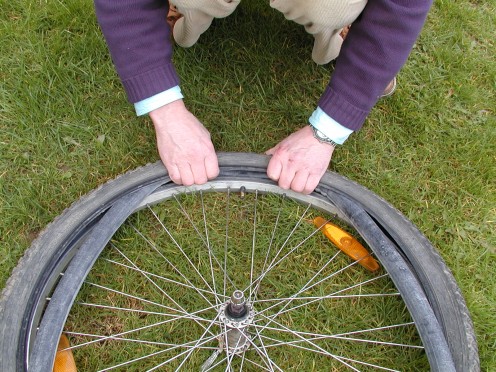 Repairing a car tire puncture with your own hands will also not be difficult even on the road. But for this you will need a pump (or compressor) and a universal tire repair kit with harnesses. All this is sold at any car market or gas station.
Repairing a car tire puncture with your own hands will also not be difficult even on the road. But for this you will need a pump (or compressor) and a universal tire repair kit with harnesses. All this is sold at any car market or gas station.
Repairing a tire on the side of the road with harnesses
The process is simple. If we are talking about the front wheels, then in most cases the wheel can not even be removed, it is enough to turn the steering wheel in the right direction, find the puncture site and carry out repairs. First, the hole is cleaned with a helical awl from the set. The tourniquet itself is smeared with glue and tucked into the eye of the awl, after which it is inserted into the tire hole. With a sharp movement, the tool is removed, and the tourniquet remains in place and clogs the hole. The tails are cut with a knife, but not at the root, it is recommended to leave about 20 mm. The tire is inflated and checked.
Sometimes a nail or self-tapping screw clogs the hole itself, remaining in it. If you see a hat in a tread, do not rush to pull it out. While the pressure is holding, move to vulcanize. And sometimes they drive with a screw in a tire for weeks.
If you see a hat in a tread, do not rush to pull it out. While the pressure is holding, move to vulcanize. And sometimes they drive with a screw in a tire for weeks.
Repair of a puncture at a tire shop
Punctures are also repaired with harnesses at a specialized service, although among professionals such repairs are not considered long-term. After a few months, the flagella dry out and can let air through. There are more advanced methods like cold and hot vulcanization. The latter is more reliable. In this case, the hole is sealed with an elastic patch, and the funnel from a foreign object is filled with a special compound. After that, a vulcanizer is put on the tire, it heats up the rubber and solders it.
In addition to the plaster, the puncture is also repaired with special cord fungi. Craftsmen process the puncture site: drill it and treat the surface with a tool to roughen it. Then the repair area is lubricated with glue (it is also called cement) and a fungus is introduced. This is done from the inside of the tire. The cap of the fungus is rolled, and the excess legs are simply cut off from the outside.
This is done from the inside of the tire. The cap of the fungus is rolled, and the excess legs are simply cut off from the outside.
Puncture repair with sealant
With the advent of tubeless wheels, and later run flat tires, many automakers began to abandon spare wheels. Instead, repair kits with compressors are supplied with the machines. A repair kit is essentially a bottle of pressurized sealant. Later, such spray cans began to appear on the shelves of ordinary car dealerships.
This method has not taken root in the CIS, because the condition of the roads makes it necessary to have at least a stowaway in the kit, but it can also be considered as a method of repair on the road.
Jack up the car and pump sealant through the nipple into the damaged wheel. Next, you should spin the wheel, then pump it up, lower the car and drive a few hundred meters.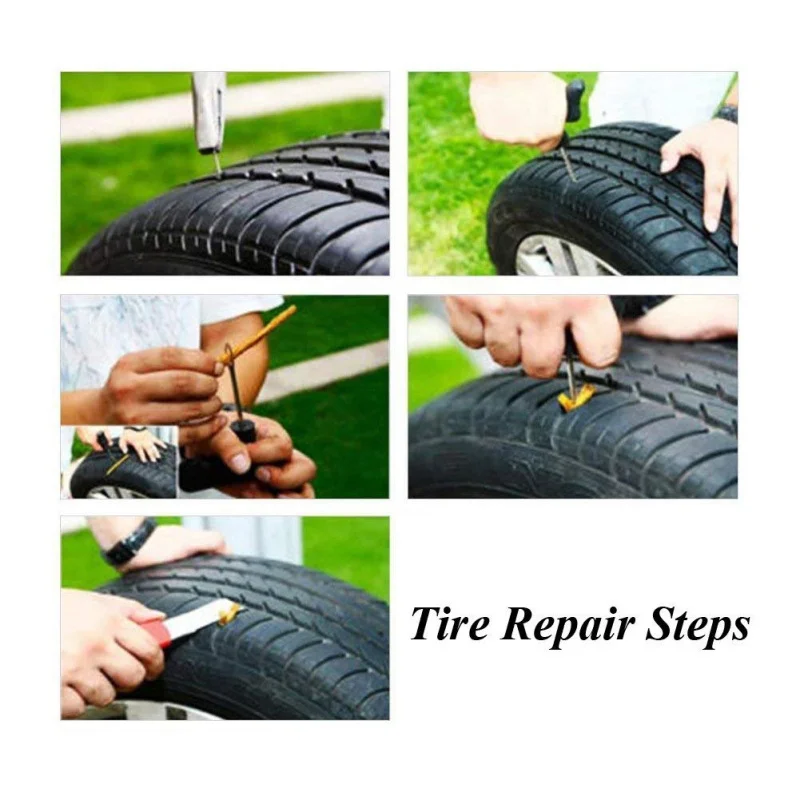 If the tire tightness has not been restored, repeat the procedure.
If the tire tightness has not been restored, repeat the procedure.
For commercial vehicles, cutting the tread with a special device (regrower) is a common thing. Moreover, such tire retreading is provided by the factory (marked REGROOVABLE on the sidewall) to increase the service life. But there are entrepreneurs who undertake to deepen the grooves in tires for passenger cars. But they are not intended for such an operation. Often used tires for sale are “refreshed” in this way. Be careful!
What is the danger?
The worst option is that the retreaded tire will shoot out on the road, because when deepening the grooves, the master can damage the undertread layer. Such a tire will not be able to hold pressure at some point. There will be a boom! At best, the tire will indeed last a little longer, but is the game worth the candle? We think it's not worth it.
How is cutting made?
A regrower is used to cut the tread. Roughly speaking, this is a large soldering iron with interchangeable tips of various shapes. It goes through rubber like a knife through butter.
Roughly speaking, this is a large soldering iron with interchangeable tips of various shapes. It goes through rubber like a knife through butter.
If the tire is for passenger cars, then it is worth taking on a regrower only in one case - when part of the tread pattern was welded with "new" rubber during repair. This is where threading comes in handy in order to restore the grooves and symmetry of the tread.
Vehicle operation is prohibited if:
— tires have a residual tread height of less than 1.6 mm;
- tires have punctures, cuts, ruptures that expose the cord, as well as delamination of the carcass, delamination of the tread and sidewall;
- tires in size or load capacity do not match the car model;
- tires of various sizes, designs (radial, diagonal, chamber, tubeless), models, with different tread patterns, winter and summer, studded and non-studded, new and restored, are installed on one axle of the car;
— Tires retreaded according to the second repair class are installed on the front axle.